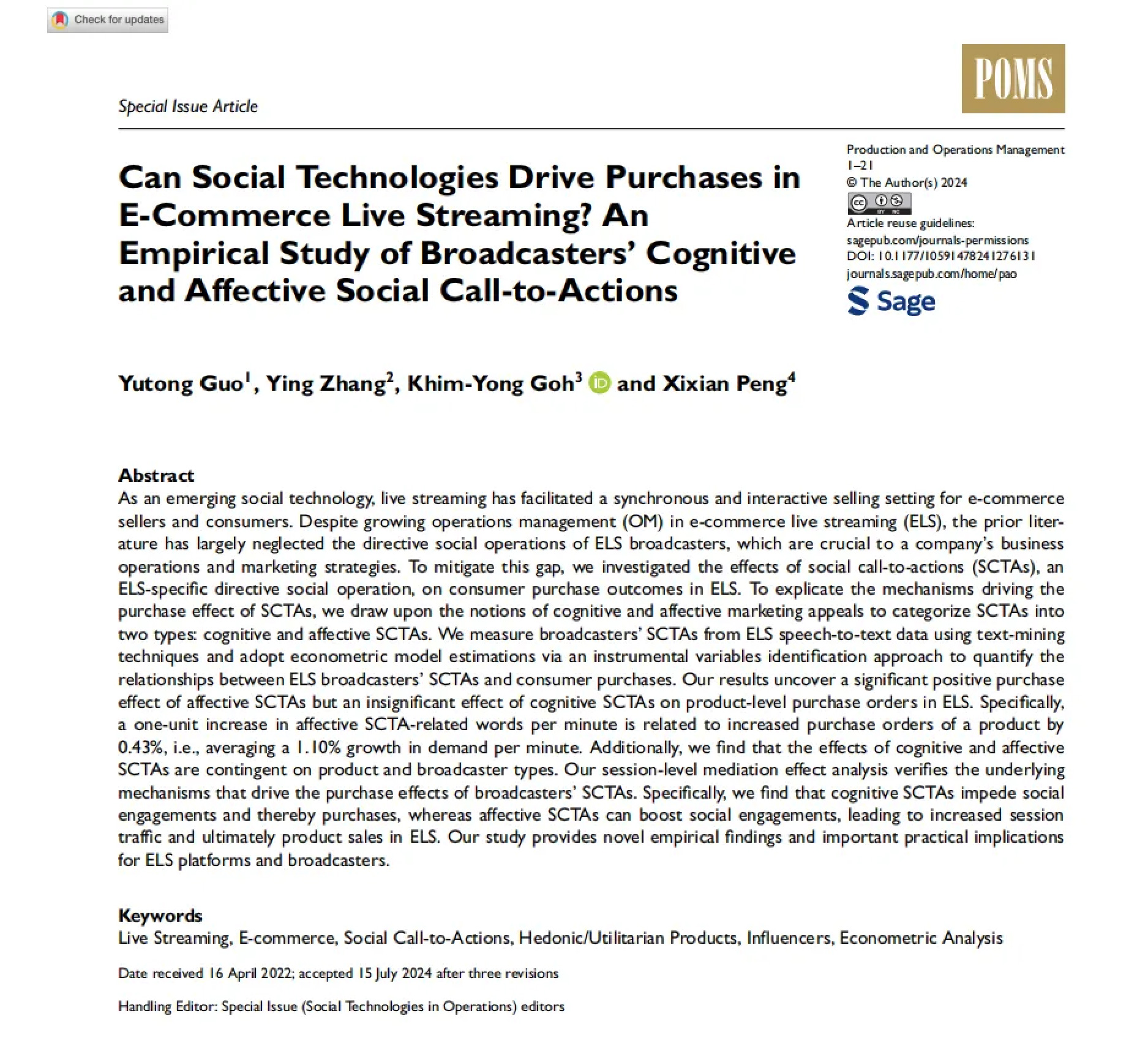“Family, give us a like!” “Follow me so you dont get lost!” If youve ever browsed products in a livestream, you likely heard these familiar phrases.
Today, livestreaming has become a popular shopping channel. Hosts enthusiastically explain products and interact with audiences in real time, recreating the feel of a lively street market. But why do some hosts drive high sales while others fall short? Could a simple like be tied to transaction volume?

|
Image source: ©千库网 |
A study co-authored by PENG Xixian (ZJUSOM), GUO Yutong (CUHK Shenzhen), Dr. ZHANG Ying (University of Auckland), and Dr. GOH Khim Yong (NUS) was published in Production and Operations Management. It reveals how livestreamers different types of social call-to-actions (SCTAs) affect sales, influenced by product category and host type.

|
Sage Journals publishing here |
|
PENG Xixian | 彭希羡 School of Management, Zhejiang University |
||
|
|
||
|
|
|
Academic Background: PENG Xixian is a researcher in the Hundred Talents Program and doctoral advisor at Zhejiang University School of Management. His research interests include human-computer/AI interaction, livestreaming commerce, and NeuroIS (Neuro-Information Systems). You can learn more about Prof. PENG Xixian’s academic background here |
|
Focusing on the “small details” within the “big trend” |
This study pioneers the use of big data to quantify the commercial value of SCTAs. It bridges a gap in academic research and provides scientific strategies for livestream commerce from operational, policy, and regulatory perspectives.
Social Media “Like”: Why It Matters
While livestream e-commerce continues to grow rapidly, research on its core mechanisms lags behind. Unlike traditional e-commerce with static visuals, livestreaming thrives on real-time interactions. How hosts guide viewers to engage socially — and whether that drives purchases — remains underexplored.
Previous studies often focused on casual interactions (e.g., greetings, thanks). This research shifts focus to directive SCTAs — deliberate prompts to like, comment, share, or follow. SCTAs are split into two categories: cognitive and affective.
Cognitive SCTAs require more mental effort (e.g., asking viewers to share the stream), while affective SCTAs involve instinctive responses (like tapping the like button). Each may trigger different behavioral outcomes.
|
In Livestreaming, Emotional Prompts Succeed — Cognitive Ones May Backfire |
Using data from 39,654 livestreams by 4,695 hosts (July–August 2020 on Taobao Live), the team applied speech recognition and NLP tools to identify and analyze SCTAs across categories such as apparel, cosmetics, and snacks.
The results were striking: affective prompts (e.g., "like this video") boosted sales by 0.43% per minute. Cognitive prompts, on the other hand, could reduce conversion rates.
Context Matters: Product Type and Host Role
Influencer-type hosts (vs. brand representatives) using cognitively demanding prompts were more likely to hurt sales. For hedonic products, like snacks or beauty items, affective prompts worked best. Complex cognitive requests (comment your thoughts) proved counterproductive.
The implication: Hosts and platforms should align their interaction style with product attributes and audience type. Platforms might also reconsider metrics that reward high interaction without distinguishing type.
|
Toward Precision: A Scientific Approach to Livestream Commerce |
The study offers new evidence on how SCTAs translate into purchasing behavior, establishing a causal chain from prompts to interaction to sales. It also innovatively combines speech recognition, text mining, and econometric methods, setting a new benchmark for livestream commerce research. By systematically categorizing SCTAs into cognitive and affective types and analyzing their divergent mechanisms, the study provides both theoretical and practical guidance to scholars, platforms, and regulators.
For practitioners, this means understanding that not all calls-to-action are equal. Simple emotional nudges like “like” and “follow” drive engagement and sales more effectively than complex prompts such as “comment” or “share.”
The findings suggest interaction strategies must be adapted to product type: for hedonic products, cognitive prompts may backfire, while emotional ones encourage effortless engagement.
- This article is part of ZJUSOM’s ongoing [Research] series highlighting impactful academic work with real-world relevance.
- You can read the original article in Chinese here